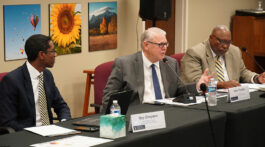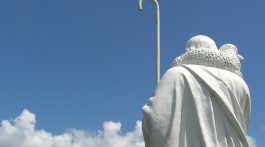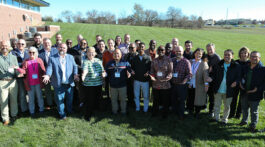The following presentation was given by Dr. David Trim during a gathering of General Conference leaders with members from the Western Slopes of the Rockies in Montrose, Colorado, in July 2023.
The Colorado Gold Rush that began in 1859 and continued in the early 1860s was one of the biggest movements of people in American history, possibly exceeding the better-known California Gold Rush of 1849. But starting ten years later, many thousands of emigrants flooded across the Great Plains to the Rocky Mountains in search of a better life in the form of gold nuggets. There was a desperate element to this surge, exemplified by the motto adopted by many “fifty-niners”: “Pike’s Peak or Bust.”
Hitherto inhabited by the Apache, Arapaho, Cheyenne, Pueblo, Shoshone, and Ute, this was the first significant influx of white population in the region. This people-boom led to the founding of the great cities of Colorado—Denver, Boulder—as well as the smaller towns that will feature prominently in this talk—Golden and Georgetown.
The Colorado Gold Rush brought Easterners and Midwesterners with their religions to the region, and Adventism was among the faiths practiced in this frontier. The history of Adventism in Colorado begins with three strong women, whose stories have heretofore only been told sketchily and incompletely.
Susan J. Bysong was a young woman residing in West Union, Iowa, when she embraced the Adventist message in January of 1863, just months before the Seventh-day Adventist Church was officially established. Excited about her new faith, she subscribed to the Advent Review and Sabbath Herald, even writing to James White, the editor. Here is an excerpt from one such letter printed in the March 24, 1863, issue, which expresses the fervency and glow of Bysong’s first love, but also the struggles she faced:
For eight weeks I have been striving to keep the Sabbath of the Lord, and am not weary in well-doing, but delight in the law of God. My heart glows with gratitude to him who first arrested my attention, opened my blinded eyes, and turned my feet into the way of truth. I praise God that I ever heard the last call of mercy. I was awakened to the truth during the labors of Bro. Cornell in this place; and I feel to give glory and honor unto God, who has delivered me from error, and made me rejoice in the truth. He is still leading me. I can truly say that I love both parts of the message, the commandments of God and the faith of Jesus. It severs the cord of friendship from this popular world, but what are the fashions, the pride of this life, when compared with the glory which awaits the faithful and obedient! O I want to share in that incorruptible inheritance, though it be by the loss of all earthly friends. We have one Friend in whom there is no variableness nor a shadow of turning. There is also a precious promise given us that the angel of the Lord encampeth round about them that fear him. O I rejoice in these glorious truths. Like the pure gold, they shine brighter and brighter. Our Saviour is soon coming. How cheering the thought! but I sometimes fear that I shall not be ready. I find a warfare daily, having many foes within. The way seems more narrow every day, but my hope and trust are in Jesus, who is worthy. I feel like striving more earnestly to gain a home in the earth made new, and with all the redeemed partake of the fruit of the tree of life.” 1
Shortly after this letter appeared, Bysong set off for Denver in a covered wagon. When she entered Colorado Territory, Bysong became a trailblazer—the first Adventist in Colorado. In the boomtown, she obtained employment with a miner’s family. But work was not all she found in Denver: Bysong married a miner named Horace G. Shaw sometime in the last years of the 1860s. There is no known photograph of them. On September 5, 1870, while living in Central City, Colorado, the couple had a son, christening him John Louis. J. L. Shaw went on to be an important administrator of early Adventism, serving as principal of Claremont College in South Africa; superintendent of denominational work in India; editor of the Oriental Watchman; secretary of Education at the General Conference, president of Washington Missionary College and the Foreign Mission Seminary (now Washington Adventist University), associate secretary of the General Conference, and treasurer of the General Conference. 2 More than anything, J.L. Shaw was a giant of foreign missions, raising funds, recruiting missionaries, promoting, strategizing, and generally building up the international missionary work. J.L. Shaw’s son, Horace J. Shaw, was a beloved professor at Andrews University. It was through the strong faith of Susan Bysong that the church was benefited by the wide-ranging service of these men of God.
In 1873, Dudley Canright visited the Shaw home in Golden, and held the first Adventist evangelistic meetings in Colorado in August and September of that year. 3 The converts from these meetings were the foundation of the burgeoning Adventist cause in the state, and the Shaw family was instrumental in establishing this base. This, too, was the ultimate fruit of Susan Bysong-Shaw’s witness.
The message comes to Boulder
The second Adventist pioneer I will highlight today is the irrepressible Amy Dartt. Again, no photograph of her survives. Amy was the second Seventh-day Adventist to settle in Colorado, this time not in Denver but in Boulder, in the early 1870s. Born Amy E. Sanford on January 11, 1805, she became a Millerite, and was disappointed with others when Jesus did not return on October 22-23, 1844. She married one Josiah Dart, who was 13 and a half years her junior, becoming Amy Dartt. 4 Like Susan Bysong, Dartt was serious about her faith, a lifelong subscriber to the Adventist Review and a vigorous literature evangelist, distributing Adventist literature in Boulder. Listen to a letter she wrote while in her late 60s to the editor of the Adventist Review:
I can say with the psalmist, Come and hear, all ye that fear God, and I will declare what he has done for my soul. A few months ago I was called to pass through a most painful ordeal. By accident, I lost use of my left shoulder and hand, for the present at least. But by the sustaining grace of God my faith and patience did not fail. And he has brought me out into a large place and established my goings and removed from me all the cares and burdens that used to weight so heavily upon me. By strictly obeying nature’s laws I have strength sufficient to walk several miles each day over these steep mountains and offer the gospel of health to the inhabitants and to circulate among them our excellent publications. Some have been much benefited by adopting the health reform. Many are investigating these subjects and quite a number have embraced present truth. We have had several Sabbath meetings. To God be the praise; for he only can reach the heart. My earnest prayer is, that God will keep these souls steadfast and unmovable, and add very many more to their numbers….5
A true pioneer, Dartt persevered in witnessing for her Lord despite painful bodily injury. When tempted to falter and give up, she powered on, winning souls to the truth. It is said that she was a familiar figure around the mining town, always carrying a basket under her arm filled with literature. To those she won to the faith, Dartt was the spiritual leader until an ordained minister arrived much later.
When James and Ellen White came to the Boulder area for much-needed rest and recuperation, Amy Dartt offered them the use of her home. Of the residence Ellen White writes simply, “We found a quiet, blessed retreat in the comfortable home of Sister Dartt.” 6
Josiah Dartt preceded his wife in death on April 6, 1881, but Amy labored on. The last we hear of her is from a little note in the Adventist Review dated October 9, 1900: “Have taken the REVIEW ever since it was published; and though I am now nearly ninety-six years old, I do not want to do without it. Hope I may yet live to see Christ come in the clouds of heaven. Inclosed [sic] find $1.50 for the REVIEW one year.” 7 Amy Dartt died months later on February 11, 1901, a pioneer of frontier Adventism.
Good work in Georgetown
The last of the trio of pioneers is Cora Thayer, later Cora Jones. Cora was married to Leo Thayer in 1867 and the couple had two daughters, Bertha and Myrtle. She accepted Adventism in 1873. 8 When her husband died tragically, Thayer migrated with her two daughters to Colorado from Battle Creek, Michigan, apparently for health reasons. The climate, air quality, and beauty of Colorado were reputed to be a natural tonic for ailments of body and mind. Thayer settled in Georgetown, Colorado, and found herself the only Seventh-day Adventist in the small town. One of the challenges of being a pioneer was that oftentimes you were alone, a solitary Adventist in a city or state. Such was Thayer in Georgetown: like Amy Dartt, a single woman braving the frontier, but with the added responsibility of single motherhood. On February 8, 1877, a note from her appeared in the Adventist Review:
“Through the kindness of a sister in Flint, I have received the REVIEW, and in this way would return thanks for it. There are a few here who are interested in the Sabbath question. I think a good work could be done here if we could have a course of lectures. The place has about three thousand inhabitants. …. I came here an invalid, but by the blessing of God my health is restored.” 9
“Good work” was done the very next year, probably because of Thayer’s urging. The able evangelist Merritt Cornell came to the state, holding meetings in Boulder and Georgetown in 1878. Cornell faced definite challenges, writing in October 1878 that “Our tent meeting in Georgetown has closed. The nights became so cold we could not make the tent comfortable with two stoves. The altitude is so great here (about 9,000 feet) that we have had frost, snow, and ice. Many of our interested hearers took cold, and dare not come out any more.” 10 Yet some were still won to the truth, including several preachers from other denominations. Cornell continued in his work, holding meetings in Sunshine, and returning the next year to evangelize Longmont, Boulder, Denver, and Fort Collins. Meanwhile, Thayer had prepared the way for these efforts by distributing literature and giving Bible studies.
Thanks to the extraordinary inaugural efforts of these three women and others who answered the call, the Colorado Conference, consisting of Colorado, New Mexico, and Wyoming, was organized on November 19, 1882, with E. R. Jones as the first president. 11 At this the founding meeting, Cora Thayer was present, and was honored for her commitment to the cause. She was elected Sabbath School Secretary for the Colorado Conference and served in that position for many years.
Crossing the Rockies
The Rocky Mountains divide Colorado into two quite dissimilar eastern and western sections, with travel very arduous between them. This was especially the case in the frontier days of wagons, stagecoaches, horses and mules. If Colorado was the West, the Western Slope of Colorado was very west, and it took Adventism significantly longer to reach that half of the state.
One man who made the trek was George Orlando States, who was born near Danville, Michigan, on March 19, 1848. He received his early schooling from his father, George William States, who was a schoolteacher. His religious education, however, he received from his mother, Harriett, who was one of the first converts to Adventism in the state of Michigan. Her family didn’t immediately embrace the message, and for many years she was alone in her faith, although rearing her children in an Adventist manner. 12
At 20 years of age, George States married Carrie Gilbert of Memphis, Tennessee. He then attended Battle Creek College, paying his way through school and providing for his wife by the trade of broom making. At Battle Creek all that his mother taught him hit home, and he felt a call to gospel ministry. In 1883 he was evangelizing up and down Michigan. 13
In the autumn of 1885 the Stateses moved to Colorado, traversing across the Rockies to Delta County and Cedaredge. The family would remain in the area until George’s death in 1917. There was another Adventist family in the vicinity by the name of Castle, and they are reputed to be the first Adventists in the Western Slope. It was in the Castle home that States preached the first Adventist sermon on the Western Slope. In February of 1887, with an Adventist minister named George Cram, States conducted a tent meeting in Montrose, the first of its kind on the Western Slope. States wrote of this meeting and his labors on March 6, 1887:
Feb. 1, I began a series of meetings thirty miles from my home, near Maher P. O., Montrose Co. This is well up the mountains, and is largely settled by cattlemen. I have already held twenty-six meetings, with a fair interest. Our first Sabbath meeting was held yesterday. One lady took a decided stand for the truth, and we hope others will do so; a number were affected to tears during our social meetings.
I find Colorado a very hard field in which to labor; the mass of the people care but little for religion. In the school-house where I held meetings, there never had been a sermon preached until I came here, and children nearly eighteen years old had never heard a sermon. Persons from the East find the ways of people here so different that it takes time to learn just how to get the truth before them; much time has to be spent in efforts to convince them of the inspiration of the Bible. I find it necessary here to dwell more on practical subjects than I did in Michigan.
Since coming to Colorado I have spent the night where there were several men playing cards at the table where I sat with my Bible, talking the truth to one or two others; indeed it is not uncommon to receive an invitation to take a smoke and join in the game. While I cannot accomplish as much here as in the East, still I believe God has a people scattered through these mountains, and I earnestly desire that I may have patience to labor on without becoming discouraged. 14
The Montrose meetings had a premature ending after an attack by a local mob. Nevertheless, States pressed on. In the April 23, 1889, issue of the Review & Herald an update of his progress appears:
During the past fall and winter, I have labored in Delta County. I have held some sixty meetings, principally among our brethren scattered through this valley. Four have signed the covenant, two of whom were baptized and united with the Crawford church. I am glad to report that the cause is slowly gaining ground in this valley. The tithe the past quarter was double any previous quarter. During the past few months I have spent some time, in connection with my other work, in canvassing for “Great Controversy,” and have had a measure of success, having sold over $220 worth of this valuable book, besides several dollars’ worth of tracts and other books. . . . I expect very soon to begin a series of tent-meetings at Fruita, Mesa County, near the Utah line. 15
The next decades saw churches organized in towns all across the Western Slope, including Aspen in 1895 and Glenwood Spring in 1899, and into New Mexico. Through the dedication of the Stateses and others, today the Seventh-day Adventist Church has a presence in Colorado on both sides of the Rockies.
Warm and liberal hearts
I conclude by quoting from James White, who spent some weeks in Colorado in 1872, strengthening believers and preaching to mining families: “There are no better fields of labor than in the States of California and Oregon, and in Washington and Colorado Territories. And there are no warmer and liberal hearts than in those who embrace the message here.” 16
In this year, when we are commemorating 160 years of Seventh-day Adventism, these intrepid men and women of Colorado stand out for their courage and persistence in the face of overwhelming odds, hardship, and loneliness. While other Colorado pioneers mined for precious metals, our Adventist pioneers sought for precious souls. The great mountains loomed over them, both literally and figuratively. They could have felt overwhelmed. But instead, refusing to accept failure, they labored in faith when they could not see the gold of human souls buried in the rock of a skeptical society. And so, with God’s help, they created in Colorado a branch of the true vine, of the remnant Church of God. The Seventh-day Adventists of Colorado, today—brothers and sisters in Christ Jesus—are the fruit of their labors. May we witness as faithfully as they did.
David Trim, Ph.D., F.R.Hist.S.
Director of Archives, Statistics, and Research
General Conference of Seventh-day Adventists
Endnotes:
- Sister S. J. Bysong, “Extract from letters,” Adventist Review, March 24, 1863, p. 7.
- General Conference Archives, Record Group 33, Box 9782; folder: “Shaw, John Louis”.
- M. Canright, “Colorado,” Review & Herald, October 7, 1873, p. 134.
- Josiah Dartt and Amy Sanford Dartt Gravestone, Columbia Cemetery, Boulder, Colorado.
- Josiah Dartt and Amy Sanford Dartt Gravestone, Columbia Cemetery, Boulder, Colorado.
- Ellen G. White, Testimonies for the Church, 9 vols. (Mountain View, CA & Omaha, NE: Pacific Press, 1948), vol. 4, 1876-1881, p. 297.
- Mrs. Amy Dartt, Review & Herald, January 1, 1901, p. 15.
- “Obituaries,” Central Union Reaper, December 21, 1943, p. 7.
- Sr. Cora Thayer, “Brief Extracts from Letters,” Review & Herald, February 8, 1877, p. 43.
- E. Cornell, “Colorado Tent,” Review & Herald, October 3, 1878, p. 118.
- “The Colorado Conference,” Review & Herald, November 28, 1882, p. 748.
- Obituary, “George Orlando States,” Review & Herald, November 29, 1917, p. 22.
- Geo. O. States, “Michigan,” Review & Herald, June 10, 1884, p. 380.
- Geo. O. States, “Colorado,” Review & Herald, March 22, 1887, p. 187.
- Geo. O. States, “Colorado,” Review & Herald, April 23, 1889, p. 268.
- “Adelia P. Van Horn,” Review & Herald, November 12, 1872, p. 176.










